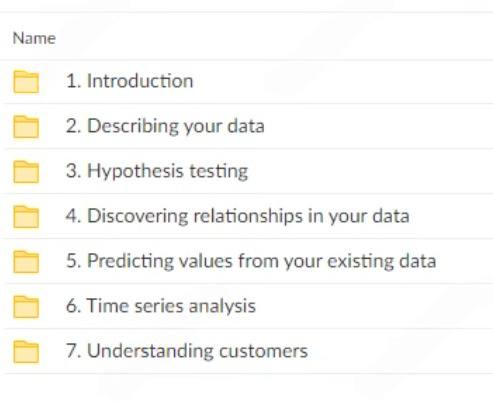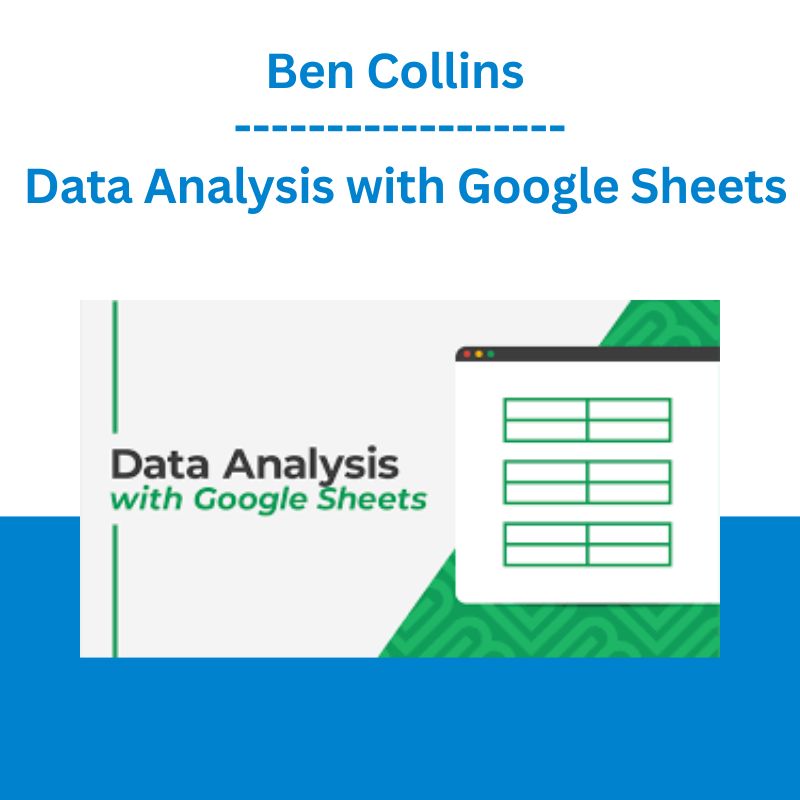*** Proof of Product ***

Exploring the Essential Features of “Ben Collins – Data Analysis with Google Sheets”
Data Analysis with Google Sheets
Learn how to make data-driven decisions in Google Sheets and transform your business
Are you drowning in data, but not using it to make better decisions?
Do you run a small business and want to use your data to inform your strategy?
Has your business migrated from Excel to Google Sheets, and you’re looking to further your skills?
Learn how to use Google Sheets to make data-driven decisions.
This course will set you up to:
- Understand and describe what your data tells you
- Predict what things might look like in the future
- Understand your customers to better serve them
- Discover what factors affect your business
- Best practices for doing all of this…
- …and much, much more!
Use your data instead of “gut” feel to put your business on the right path.
Each lesson is taught through bite-sized, action-oriented 5 – 10 minute-long videos, covering practical techniques you can apply to your own business.
Working with real-world examples, including example datasets from industries like sales, marketing, real-estate and social media, you’ll learn how to make the most of your business data today.
Now you can learn data analysis, using the same techniques and best practices I’ve spent the past 15 years learning.
This course will teach you the key foundational techniques in data analysis, even if you’re new to this topic.
As part of this course development, I had a group of people test-drive the course.
I’ll tell you more about the course in a moment…
…but first let me reassure you:
I’ve made just about every mistake in the book
Prior to consulting and creating courses, I worked as a forensic accountant, doing investigations into sanctions violations at large financial organizations.
We used Excel and SQL to manage our project data — hundreds of thousands of transactions that we would analyze for the legal team.
There was one time I working on the master Excel dataset for a few days, but the unique identifier column was hidden. These unique IDs were therefore omitted from all the filters and sorts.
I had a total panic when I realized that the ID numbers were now totally out of sync with the related data, and there was no way for anyone to now reference the data.
(Thankfully, I was able to create a new unique identifier based on the data, and use that to retrieve the IDs from an older copy of the dataset, where they weren’t messed up.)
I learnt the valuable lesson of being careful with my data and keeping a good audit trail — something we discuss throughout this course.
It was also around this time that I realized how valuable solid data and spreadsheet skills were, and I’ve taken every opportunity to further my skills since then.
Fast forward to today
Today I create online courses and write about working with data, with a particular focus on how-to articles for learning data analytics and building dashboards, using Google Sheets, Apps Script and Data Studio.
Since mid-2015, I’ve been working as a freelance spreadsheet developer, data consultant and instructor.
I’ve taught data analysis and visualization courses and workshops at General Assembly’s Washington, D.C., campus and privately for clients.
The missing piece
This data analysis course is my third premium course.
It fills the gap between the data cleaning course and the dashboard reporting courses, which hundreds of students have taken, to cover the whole data analysis process:
Josh wanted to be a data analyst, so he took a data analysis course to accelerate his career
Josh was one of my students in the first Data Analysis class I taught for General Assembly in Washington, DC. (In that course, I taught data analysis fundamentals with Excel, but the topics were similar to what I now teach in Google Sheets.)
Today, less than 3 years later, he has a masters degree in predictive analytics and works as a fully fledged data scientist. Wow!
Thanks Josh!
What amazes me about Josh’s story is how quickly he’s advanced his career, by working hard and grabbing every opportunity that came his way.
For Josh it began by leveling up his Excel skills and learning the foundational data analysis techniques in the first Data Analysis course I taught at General Assembly.
You never know what doors might open when you take that first step, but you can bet that investing in your data skills will pay off in this day and age.
Perhaps you dream of becoming a data scientist like Josh, or perhaps you simply want to extract more value from your business data. In either case, this course will help you learn the foundations of data analysis, in a clear and concise way.
Thanks for sharing your story Josh!
There’s never been a better time to learn data analysis than right now
Demand for data analysts and data scientists is soaring and will continue to do so for decades to come. It’s fast becoming a necessary skill to get along in today’s job market.
Our jobs, even our lives, are becoming more dependent on data and an ability to understand, interpret and communicate with data.
I love it when I come across examples of data analysis in the real world:
Example 1:
I recently read a brilliant book about paleontology, called The Rise and Fall of the Dinosaurs, by Steve Brusatte. It tells the story of the origin and demise of the dinosaurs, which is absolutely fascinating. Half-way through the book, he included this wonderful correlation example from his line of work:
“Scientists have measured the limb bones of many living animals, and it turns out that the thickness of the main bone in each limb that supports the animal […] is strongly statistically correlated with the weight of the animal. In other words, there is a basic equation that works for almost all living animals: if you can measure limb-bone thickness, you can then calculate body weight with a small but recognized margin of error”
Example 2:
Another example was a recent article in the Economist magazine, from June 30th this year, about Netflix’s success. The article mentioned an assessment from Goldman Sachs that found subscriber growth was correlated with the rate at which Netflix added new content.
It figures they have huge subscriber numbers then, since Netflix spend billions on content creation each year (this year they’re launching 82 feature films and over 700 TV shows!).
Example 3:
Even more recently, The New York Times published a super interesting article about their statistical analysis of the new Nike Vaporfly shoes, and whether they made a difference to a runner’s time. Based on exhaustive analysis, using many different approaches, the answer appears to be yes. Yes, these shoes really do make your run faster…
A solid grasp of the fundamentals is 100x more important than keeping up with flashy trends
There are a lot of exciting new technologies and techniques being applied to data today. Machine learning, neural networks, facial recognition, Tensorflow, etc… but these are designed for big, really big data, and operate at the cutting edge of the field.
However, unless you have a team of data scientists and terrabytes of data, you’re unlikely to want or need the latest and greatest data trends.
What you really need is insights. Answers to questions like what’s the average lifetime value of my customers? What was my churn rate last month? If I spend $100k on marketing this year, what’s my expected ROI?
And to answer questions like those, you don’t need the flashy stuff.
You need a solid grasp of the fundamental techniques of data analysis. Techniques like linear regression, correlation and customer analysis.
And that’s exactly what I teach in this course.
About the course
If you want to…
- Describe and understand your datasets
- Test your hunches and confirm or disprove what you believe your data is telling you
- See how to convince your boss of your ideas backed up with rigorous results
- Predict outcomes based on your existing data
- Understand trends in your data over time, so you can identify successful events
- Understand your customers better, to better serve them
…then Data Analysis with Google Sheets is for you.
Inside this course I share all the knowledge I’ve built up over the past 15 years working with data in spreadsheets.
I’ve packaged it all into a series of simple, bite-size video lessons, complete with Google Sheet templates, that anyone can follow.
Enroll now to get:
✅ Actionable, bite-size video lessons teaching key data analysis topics
✅ All raw datasets for you to follow along
✅ All solution files for your own use
Ok data geeks! Here are the details for every module you get in this class:
📚 7 modules | 45 videos | 20 templates
Each video breaks down a particular topic in data analysis and Google Sheets, and allows for quick referencing in the future. You can watch them in any order you like, spread them over a few weeks or months, or even binge watch them all today if you like!
Module 1: Introduction
- What is data analysis
- A framework for approaching data analysis problems
- Best practices in Google Sheets
- Glossary of Data Terms
- Guide to the most useful keyboard shortcuts in Google Sheets, for Macs, PCs and Chromebooks
Module 2: Describing your data — Learn to:
- Do exploratory data analysis
- Determine the key measures of a dataset
- Present these findings to colleagues
Module 3: How different is your data? Learn to:
- Test, test, test!
- Formulate and test hypotheses about your data…
- …so that you can confidently talk about your data (and know what you’re saying is statistically significant)
- Run a number of different statistical tests so you can move beyond the “gut feel” approach to data
Module 4: Discovering relationships in your data — Learn to:
- Determine if two variables are correlated
- Calculate a variety of correlation metrics
- Avoid a variety of common mistakes
Module 5: Predicting values — Learn to:
- Build models using regression so that you can make predictions based on your existing data
- Test your models so you’ll know if they’re any good
- Build a spreadsheet interface running your regression model in the background
Module 6: Time series analysis — Learn to:
- Use a variety of ways to smooth your time series data to understand underlying trends
- Use the SOLVER add-on to optimize models
- Test your models to choose the most appropriate one
Module 7: Customer analysis — Learn To:
- Calculate customer lifetime value and find your most valuable cohorts
- Calculate your churn and retention rates to identify where customers drop off
- Draw retention curves to present results to your colleagues/bosses/clients
Please see the full list of alternative group-buy courses available here: https://lunacourse.com/shop/










 Dave Landry - Stock Selection Course
Dave Landry - Stock Selection Course  Emanuele Bonanni - My Trading Way
Emanuele Bonanni - My Trading Way